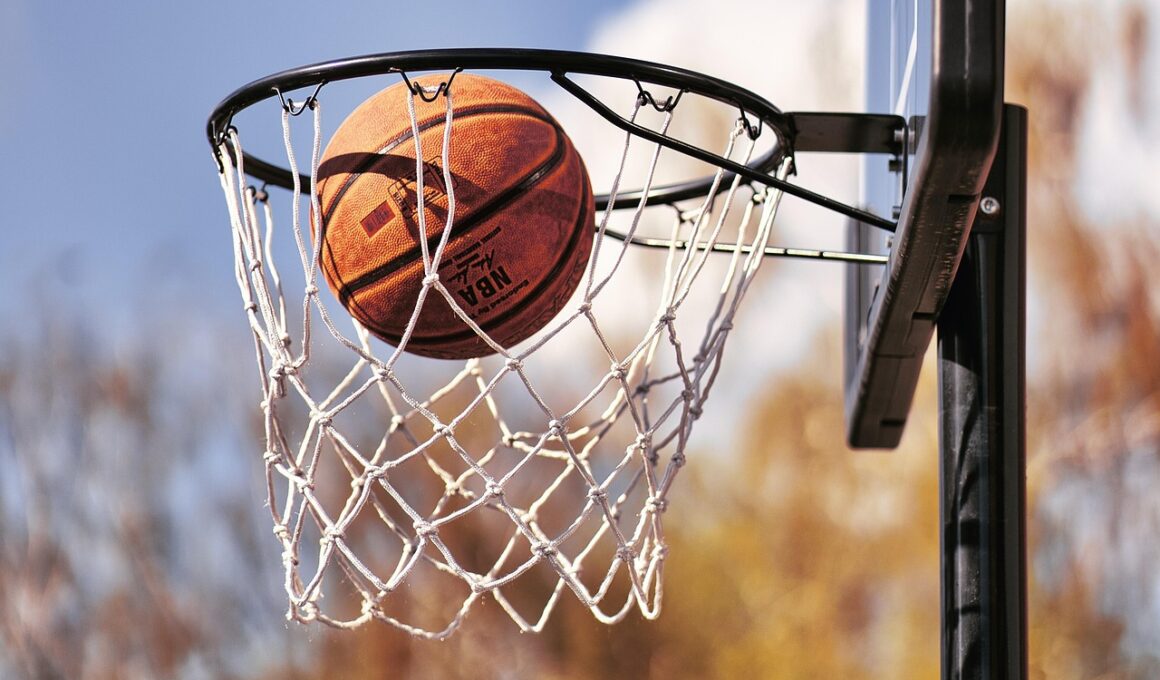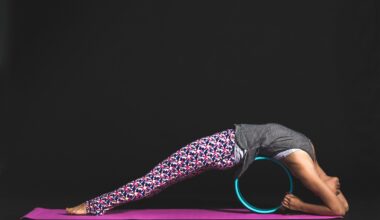Using Resistance Bands for Basketball Strength Development
Basketball requires a balanced blend of speed, agility, and strength. Among the tools available for players to enhance their physical abilities, resistance bands stand out due to their versatility. These bands promote effective strength training tailored for basketball players by improving muscle stability, strength, and explosiveness. Many basketball drills can be modified to include resistance bands, allowing players to enhance their training regimen. In addition, resistance bands can be utilized for rehabilitation purposes, helping athletes recover from injuries while maintaining strength. It’s crucial to select the right band for your fitness level; bands are available in different resistance levels. Beginners might want to start with lighter bands, while advanced players may ramp up to thicker bands. To maximize results, athletes should integrate resistance bands into their regular workout routines, focusing on specific movements that replicate basketball actions. Concentrating on exercises that build lower body strength is essential since much of the force is generated from legs. Players should combine resistance band training with traditional weightlifting to develop overall fitness. Consistency is key to ensuring players see improvements over time, leading to better performance on the court.
Resistance bands are often overlooked in favor of free weights, yet they offer unique benefits. One of the strongest advantages is their ability to provide variable resistance throughout the range of motion in exercises. Unlike traditional weights, resistance bands engage muscles differently, which can lead to improved muscle activation. This is particularly beneficial for developing the specific muscle groups needed in basketball, such as the quadriceps, hamstrings, glutes, and calves. Consequently, incorporating these bands can lead to better on-court performance and injury prevention. Additionally, athletes can perform exercises at home or away from the gym, making them accessible and convenient. The mobility of resistance bands allows for a range of movements that target different muscle groups. Popular exercises include band squats, lateral band walks, and resistance band shoulder presses. These exercises can also be done as part of a warm-up routine to prepare the body for more strenuous activity. Moreover, resistance bands facilitate both upper and lower body workouts, ensuring comprehensive strength development. Furthermore, players can adjust the tension of the bands by changing their position, ensuring suitable resistance for effective workouts.
Benefits of Resistance Bands in Strength Training
The versatility of resistance bands is unmatched. They not only provide resistance training but also assist in enhancing flexibility. As players engage in resistance training, they should focus on ensuring a full range of motion in their exercises. This is essential not just for getting stronger but also for increasing the elasticity of the muscles. Increased flexibility has a positive impact on overall athleticism and can help prevent injuries. Moreover, utilizing bands during strength training can enhance stabilization around the joints. When players develop stability in their movements, it can translate to better body control while performing on the court. Furthermore, incorporating bands into propulsion drills allows for improved explosiveness. By mimicking the motions of basketball, players can achieve greater muscle memory, leading to improved performance in games. Resistance bands can also simulate ideal jumping movements used during layups or rebounds. These bands are portable and can be used in any space, making them an excellent option for training away from a traditional gym. Players can easily pack bands in a bag without ergonomic limitations, allowing for spontaneous workout opportunities that fit into their busy lives.
Strength training with resistance bands can also improve basketball-specific skills. For instance, players should focus on developing core strength since a strong core translates directly to better performance in dribbling and shooting. Exercises like seated band rotations and diagonal presses can effectively strengthen this area. Additionally, having a solid core is fundamental in maintaining balance and coordination through various movements on the court. Players are not just developing strength; they’re also addressing major biomechanical aspects critical to their game. The tension offered by bands during workouts requires athletes to engage stabilizing muscles, thus promoting greater functional strength. That being said, players should incorporate bands into plyometric exercises, such as jump squats and lateral bounds. This promotes effective engagement and faster explosive movements. Training in this manner has proven tremendously beneficial, allowing players to cover more ground swiftly as they sidestep defenders in games. Also, engaging in strength training with resistance bands generally takes less time than traditional weight training, allowing for efficient, focused workouts. With the combination of effective strength training, basketball players will see noticeable results in their performance when they consistently apply these techniques during practice sessions.
Incorporating Resistance Bands into Training Regimens
To successfully incorporate resistance bands into a training regimen, it’s important to design workouts that focus on specific basketball-related movements. For instance, conducting dribbling drills while using bands around the lower legs can enhance lower body strength and resistance during practice. Pairing band exercises with plyometric drills can also improve explosiveness crucial for jumping and sprinting. Athletes should aim for two to three sessions per week dedicated to resistance band workouts, ensuring recovery time between sessions. Each workout could include compound movements such as band-supported squats, lunges, and glute bridges to enhance strength effectively. A balanced routine might consist of five to ten exercises targeting multiple muscle groups, providing holistic development. It’s critical for athletes to track their progress, which can be achieved by gradually increasing the resistance as strength improves. Keeping a workout journal allows players to reflect on their achievements over time. Players should not hesitate to mix in free weights with resistance training; this combination can be powerful for building endurance and developing muscle strength. Lastly, developing a warm-up routine focused on mobility before engaging in resistance band exercises will prepare the body for increased physical demands, setting the stage for improved performance.
Overall, the integration of resistance bands in basketball strength training programs proves effective. The adaptability of the bands allows for seamless incorporation into existing workout routines while providing crucial benefits that transcend mere strength development. Players often discover that these bands can take their skills to new heights, improving not only strength but also agility and responsiveness. With a proactive training mindset, athletes will significantly reduce their injury risks, allowing for consistent play throughout the season. The key is understanding how to effectively utilize bands in terms of resistance and movement patterns, tailoring workouts to meet individual player needs. Consistent application of resistance band exercises leads to observable gains in strength, balance, and performance on the court. Many players have reported significant improvements in their vertical jump and overall power due to regimented training with bands. Additionally, coaches can emphasize these methods during practices, further reinforcing the use of bands for skill development. Athletes should look at strength training holistically, not limiting themselves to traditional exercise forms. Enthusiastic adoption of these versatile tools encourages a new era of basketball training, ensuring athletes of all levels can harness their full athletic potential.
Conclusion
The insights gained from incorporating resistance bands into a basketball strength training regimen are invaluable. Evidence supports the effectiveness of band training for improving athleticism in young and seasoned players alike. Athletes are empowered by the increasing awareness of various training techniques, particularly those promoting injury prevention and muscular development. By strategically implementing bands into workouts, players can work the muscles needed to excel on the basketball court. There’s no denying that strength is foundational in basketball, impacting everything from speed during plays to the ability to withstand contact. With the right approach and commitment, players should anticipate remarkable outcomes in their strength and overall competitive performance. The investment in proper equipment paired with a tailored training routine will favorably influence results on the court. Engaging in resistance training using bands caters to individualized strength and conditioning goals, shaping athletes to be versatile players. The fusion of strength training with basketball skills can lead to transformative developments, reinforcing the players’ positions during their game. In summary, resistance bands are an essential addition to any basketball training plan, proving their worth among traditional strength training options.
Ultimately, the journey toward advanced strength, agility, and skill on the basketball court involves diverse training modalities, with resistance bands offering substantial advantages. Utilizing bands ensures that basketball players can maintain strength tailored for their sport while preventing injuries through enhanced stability and flexibility. The versatility in workouts contributes to a well-rounded athlete that can face various challenges during games. Integrating bands into training also promotes creativity in workout routines, never allowing workouts to become monotonous or tedious. Athletes can take ownership of their training by experimenting with exercises that resonate most with their personal experience. Additionally, engaging with a knowledgeable coach or trainer can further enhance the quality of the resistance band strength training program. As the basketball community continues to evolve, incorporating new training methods will undoubtedly shape the future of athlete performance. To maximize the benefits, players should seek out more resources, including online tutorials or expert guidance that can provide insight into the latest techniques. Through dedication and effective use of resistance bands, long-lasting athletic improvements can be achieved. With this commitment to training, players, coaches, and fitness professionals will nurture elite performance and understand the true potential of strength development in basketball.


